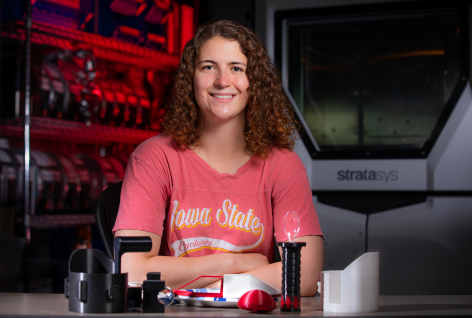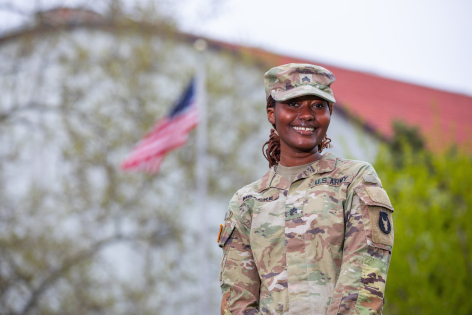AMES, Iowa – For Cassandra Swacker, engineering is a way to help people.
Majoring in mechanical engineering and minoring in biomedical engineering at Iowa State University equipped Swacker with the skills to design and manufacture personalized utensils and devices for people with traumatic brain injuries.
Her quest to help others through engineering began while she was in high school, when she saw how a prosthetic leg changed her father’s life. She’ll graduate at the end of this semester, which concludes this week, and her engineering quest will continue as she begins her career developing innovative solutions in technology and manufacturing.
“Biomedical engineers need to be involved in all those things to understand the biology and anatomy components of how machines interact with people,” Swacker said. “They also need to understand the design and manufacturing processes of those machines.”
Improving lives through engineering
Swacker, an Urbandale native, witnessed the power of biomedical engineering when her father was diagnosed with ankylosing spondylitis, a type of arthritis that can affect the spine, knees, ankles and hips. The condition caused severe wear on her father’s ankle bones. He had metal plates implanted but eventually elected to have his leg amputated below the knee and replaced with a prosthetic.
The prosthetic improved her father’s mobility dramatically. Around the same time, Swacker took an engineering design course in high school, and she started thinking about how engineering affects people, including her father, in countless ways.
“My brain had that little lightbulb moment of, ‘oh, the people who are making prosthetics are engineers,” she said.
She discovered biomedical engineering, a fast-growing field that utilizes innovations in materials and technology to develop devices and equipment to enhance human and animal health.
“When he finally got his prosthetic and I was able to see just how big of an improvement it made for him, it was really inspiring and I wanted to be able to have that direct of an impact on peoples’ quality of life, which got me interested in the biomedical field,” Swacker said.
She enrolled at Iowa State because of the university’s strong engineering programs and proximity to family. She decided to major in mechanical engineering and pick up a minor in biomedical engineering.

Cassie Swacker, graduating in mechanical engineering and biomedical engineering, with some of her 3D-printed life aides inside Black Engineering’s 3D printing lab. She worked with CIRAS to line up an internship with On With Life to design custom tools for patients using 3D printing technology. (Christopher Gannon/Iowa State University) Larger image. |
Made-to-order medical devices
Swacker began her first year at Iowa State during in the fall of 2020, at a time when the pandemic forced most classes to be held remotely. The challenges of the pandemic taught her to work independently on her courses. They also helped her appreciate the classroom experience when in-person instruction resumed.
She landed an internship with Iowa State’s Center for Industrial Research and Service, which partners with business and communities across Iowa to develop tailored strategies to grow and prosper. In just the last five years, CIRAS and its partners have helped more than 4,600 businesses in every Iowa county, creating an economic impact of more than $3.1 billion.
Among the organizations helped by CIRAS is On With Life, an Ankeny-based rehabilitation clinic that helps patients recover from traumatic brain injuries and other neurological conditions. Swacker saw an opportunity with On With Life to apply what she was learning in her biomedical engineering courses.
Because brain injuries manifest a wide range of symptoms, On With Life’s patients often require personalized equipment and devices. 3D printing technology offers a way to create unique devices to precise specifications, so Swacker got to work familiarizing herself with the technology.
She custom-built eating utensils, such as plate covers and silverware handles, for patients whose injuries affected their fine motor skills. The adaptive plate cover she developed clips onto the top of a plate with strategically placed gaps that expose only a portion of the food. This helped a patient whose brain injury caused a compulsion to eat too fast to slow down to a healthier pace.
On With Life CEO Jean Shelton praised Swacker’s work.
“Brain injury rehabilitation calls for an individualized approach to services,” Shelton said. “No one brain injury is like another due to the many functional areas of the brain. We are grateful for Cassie’s work as she was able to address a very specific need through technology that aids an individual and their family to manage impulse control related to food. The plate she created allowed for a balanced meal approach without the visual distraction of the other foods on the plate. The plate is still in use!”
Swacker even developed an eye for aesthetics in her 3D printing designs. She learned one particular patient, who was a fan of Harley Davidson motorcycles, didn’t like the way some of the specialized eating utensils looked. So she designed one to resemble the handlebar of a motorcycle, complete with a flame finish. Many of her designs got rave reviews from the end users, she said.
Her work with CIRAS and On With Life taught her numerous lessons about engineering design, utilizing cutting edge technology and problem solving.
In the months ahead, Swacker said she plans to move to the Iowa City area to pursue a career in manufacturing engineering. She said she’ll apply all the lessons she learned studying at Iowa State and working for On With Life as she begins her career, lessons like never hesitating to ask questions and forging relationships with the people she’s working with.
Perhaps most importantly, she’ll launch her career with firsthand knowledge that good engineering can help people and change lives.
Contacts
Cassandra Swacker, mechanical engineering, cswacker@iastate.edu
Fred Love, News Service, 515-294-0704, fredlove@iastate.edu
Quick look
Cassie Swacker’s quest to help others through engineering began while she was in high school, when she saw how a prosthetic leg changed her father’s life. She’ll graduate at the end of this semester, and her engineering quest will continue as she begins a career developing innovative solutions in technology and manufacturing.
Quote
“When he finally got his prosthetic and I was able to see just how big of an improvement it made for him, it was really inspiring and I wanted to be able to have that direct of an impact on peoples’ quality of life, which got me interested in the biomedical field.”
Cassie Swacker, graduating senior in mechanical engineering and biomedical engineering
Quinton's story
Khadija's story
From Senegal to Kosovo to Ames, it seems like Khadija Mbacke has been everywhere and done it all. At the conclusion of this semester, Mbacke will be able to add college graduate to her long list of accomplishments and experiences. Resources she discovered at Iowa State helped her get here. Read Khadija's story.
Commencement information
Nearly 4,600 students are expected to complete degrees this spring. That includes an estimated 3,866 undergraduate students, 575 graduate students and 157 veterinary medicine candidates. Iowa State will hold five commencement ceremonies. Full commencement information.
More news
Find more Iowa State University news and research stories at news.iastate.edu.
